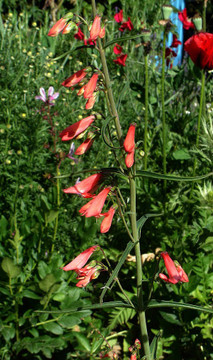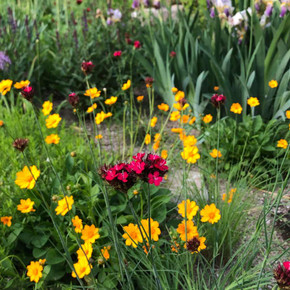
Dianthus barbatus 'Nigrescens' (='Sooty') - SWEET WILLIAM 'SOOTY'
Old fashioned plant with fragrant flowers, excellent cut flower.
Maroon-black clusters in late spring and early summer. Flowers look nearly black, when the sun is low (mornings, evenings).
Short-lived perennial or biennial.
Award of Garden Merit by RHS (Royal Horticultural Society, Great Britain).
Size: 16-18"' tall tall x 12" wide, clumps
Flowering time: May/June (can rebloom in late summer in cooler areas, especially if cut back).
USDA Zones: 3-9
Culture: sun, half sun, prefers drained to well drained soil with average moisture (medium) to medium-dry soil. Average, sandy, rocky, gritty soils. Avoid waterlogged soils (suffers with crown rot with too much moisture or in too heavy soils). Avoid heavy mulching with organic material - can cause crown rot.
Moisture Needs: medium (average), medium-dry
Origin: Europe, Eurasia
Deer/Rabbit Resistant: resistent to both
Attracts Butterflies or Pollinators: some butterflies and some bees
Attracts Hummingbirds: yes
Plant Combinations: Best in cottage gardens, fronts of the flower beds, cut flower gardens. Often self-seeds and stays around. Good with many common perennials that prefer somewhat drrained or drier soils like Achillea, Agastache, summer blooming Allium, Asclepias tuberosa, smaller Baptisia, Calamintha, Coreopsis, Echinacea, Gaura, bearded Iris, Knautia, Liatris, Nepeta, Oenothera, Peaonia, Penstemons, Platycodon, Salvia nemorosa hybrids, tall Sedum, Stachys, Veronica, Yucca, and grasses like Bouteloa, Muhlenbergia, Sporobolus, Schizachyrium scoparium, Sorghastrum.
Pot Size: square 3.5" x 4" deep perennial pot
Picture Copyright: 1- Alvin Kho, Flickr, 2,3 - US Perennials

Dianthus barbatus 'Nigrescens' (='Sooty') - SWEET WILLIAM 'SOOTY'
Old fashioned plant with fragrant flowers, excellent cut flower.
Maroon-black clusters in late spring and early summer. Flowers look nearly black, when the sun is low (mornings, evenings).
Short-lived perennial or biennial.
Award of Garden Merit by RHS (Royal Horticultural Society, Great Britain).
Size: 16-18"' tall tall x 12" wide, clumps
Flowering time: May/June (can rebloom in late summer in cooler areas, especially if cut back).
USDA Zones: 3-9
Culture: sun, half sun, prefers drained to well drained soil with average moisture (medium) to medium-dry soil. Average, sandy, rocky, gritty soils. Avoid waterlogged soils (suffers with crown rot with too much moisture or in too heavy soils). Avoid heavy mulching with organic material - can cause crown rot.
Moisture Needs: medium (average), medium-dry
Origin: Europe, Eurasia
Deer/Rabbit Resistant: resistent to both
Attracts Butterflies or Pollinators: some butterflies and some bees
Attracts Hummingbirds: yes
Plant Combinations: Best in cottage gardens, fronts of the flower beds, cut flower gardens. Often self-seeds and stays around. Good with many common perennials that prefer somewhat drrained or drier soils like Achillea, Agastache, summer blooming Allium, Asclepias tuberosa, smaller Baptisia, Calamintha, Coreopsis, Echinacea, Gaura, bearded Iris, Knautia, Liatris, Nepeta, Oenothera, Peaonia, Penstemons, Platycodon, Salvia nemorosa hybrids, tall Sedum, Stachys, Veronica, Yucca, and grasses like Bouteloa, Muhlenbergia, Sporobolus, Schizachyrium scoparium, Sorghastrum.
Pot Size: square 3.5" x 4" deep perennial pot
Picture Copyright: 1- Alvin Kho, Flickr, 2,3 - US Perennials










